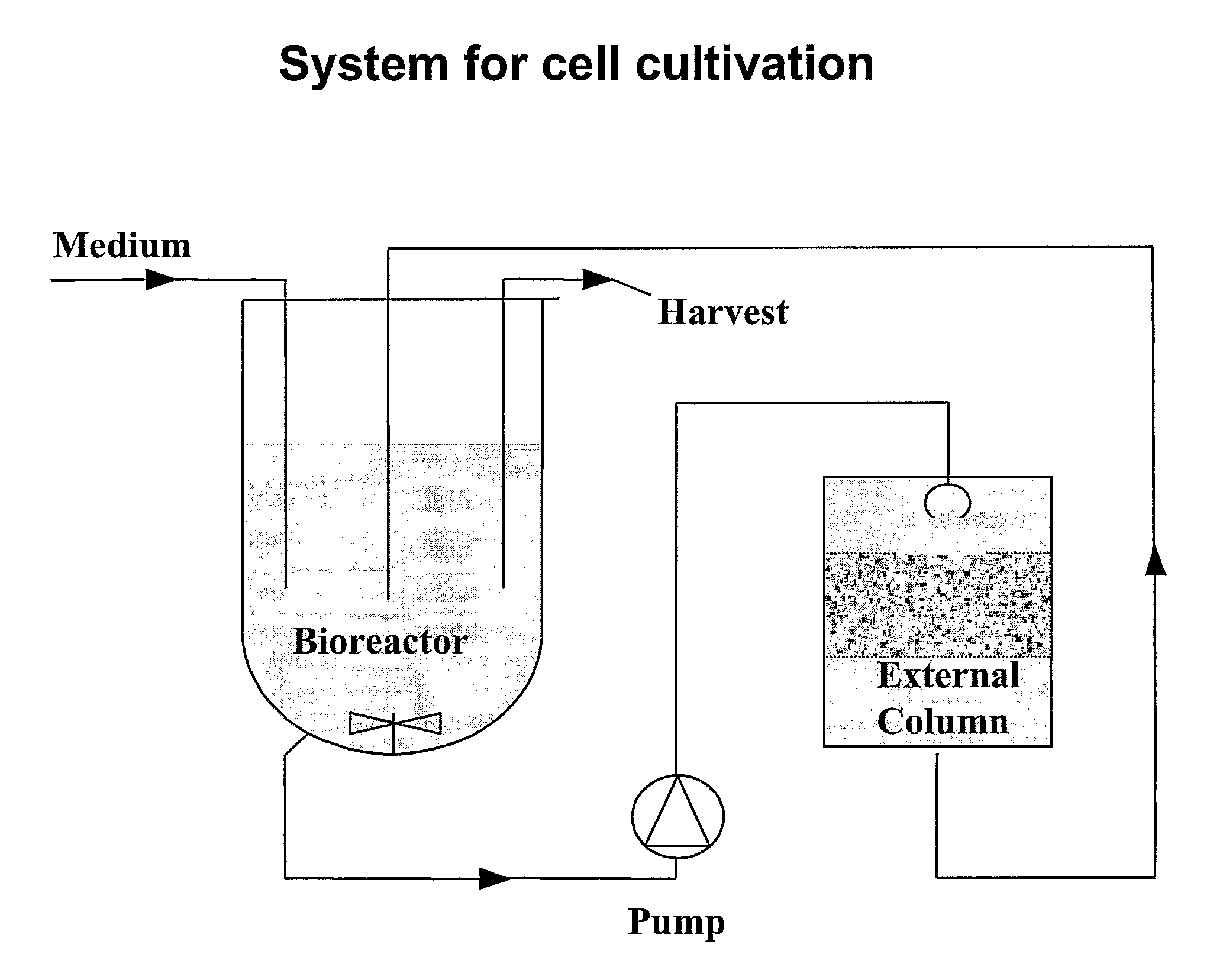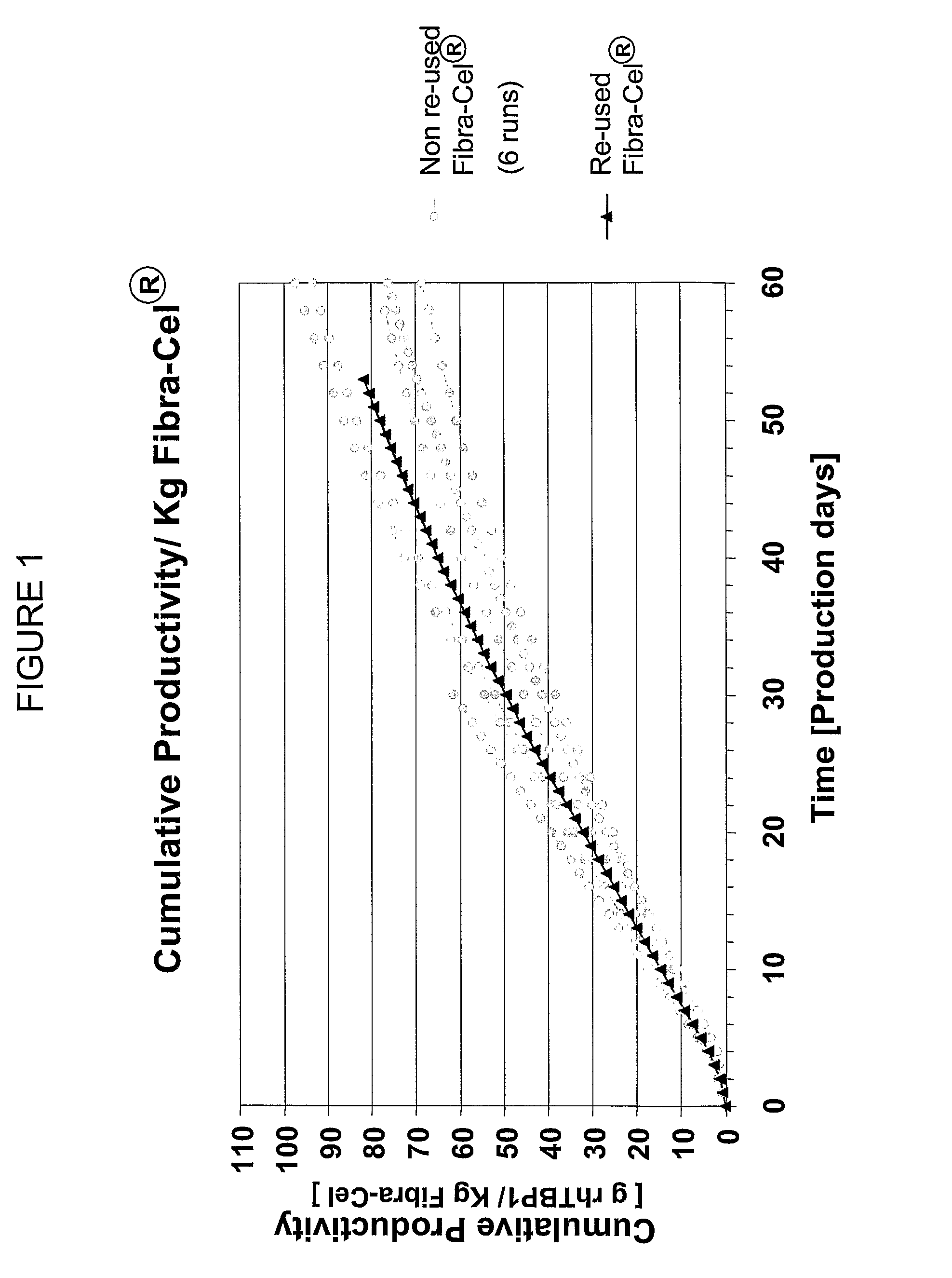Process For Recycling Solid Supports For Cultivation Of Anchorage-Dependent Cells
- Summary
- Abstract
- Description
- Claims
- Application Information
AI Technical Summary
Benefits of technology
Problems solved by technology
Method used
Image
Examples
example 1
Cell Culture Process
[0085] 1.1. Equipment
[0086] All experiments were performed with systems composed of a bioreactor connected to an external column The configuration of the bioreactors was similar to the configuration of 40 liters Free-Standing Laboratory bioreactors manufactured by New MBR. The volume of the bioreactors and columns that were used are summarized in Table 1 below.
TABLE 1Bioreactor volumeColumn volumeMass of Fibra-Cel disks 15-liter5.5-liter0.6-kg 40-liter60 to 120-liter6.6 to 13.2-kg350-liter120 to 240-liter13.2 to 26.4-kg
[0087] The external columns were made of inox 316L, with a Ra of 0.6 μm. The Ra describes the average surface roughness and is defined as an integral of the absolute value of the roughness profile measured over an evaluation length: Ra=1l∫0lz(x)ⅆx
The external column were packed with Fibra-Cel® disks (New Brunswick Scientific) according to the mass of carriers given in Table 1.
1.2. Cell Lines and Media
[0088] 1.2.1. Cell Lines
[0089] All...
example 2
Analytical Methods
[0106] 2.1. Measurement of the Total Organic Carbon (TOC)
[0107] Total organic carbon (TOC) is an indirect measure of organic molecules present in pharmaceutical water measured as carbon. TOC is commonly used as a process control attribute to monitor the performance of unit operations comprising the purification and distribution system. TOC allows determining whether all organic molecules have been removed after cleaning. A number of methods exist for analyzing TOC (see, e.g., European Pharmacopeia, 4th Edition, 2002, Chapter 2.2.44).
[0108] The TOC was measured using a Phoenix 8000 apparatus (Dohrmann) according to a protocol derived from the manufacturer's instructions. The TOC was expressed in parts per million (ppm).
[0109] 2.2. Measurement of the Limulus amebocyte Lysate (LAL)
[0110] The Limulus Amebocyte Lysate (LAL) test is a test to detect or quantify bacterial endotoxins that may be present in or on a sample to which the test is applied. It uses Limulus A...
example 3
Recycling Protocol and Results
[0124] 3.1. Recycling
[0125] The system was composed of a 15 liters bioreactor connected to a 5.5 liters external column as described in Example 1.1.
[0126] At the end of a run carried out with non-recycled Fibra-Cel® disks, the entire system was emptied of all liquid and then refilled with hot Water For Injection (WFI). The temperature of the WFI was superior to 70° C. The circulation loop flow was set at 583 l.h−1.kg−1 during 10 nm (5 nm top / down flow and 5 nm down / top flow). The overpressure was of 300 mbars. Then, WFI was drained.
[0127] The system was refilled with WFI and a concentrated sodium hydroxide solution (10%) was added to reach a final concentration in the system of 2%. Then, the rotary lobe pump flow rate was progressively increased from 215 to 583 l.h−1.kg−1 and maintained at this latter circulation loop flow rate during 30 nm (15 nm top / down flow and 15 nm down / top flow) at a temperature of 60° C.
[0128] Afterwards, one to four rinses...
PUM
 Login to View More
Login to View More Abstract
Description
Claims
Application Information
 Login to View More
Login to View More - R&D
- Intellectual Property
- Life Sciences
- Materials
- Tech Scout
- Unparalleled Data Quality
- Higher Quality Content
- 60% Fewer Hallucinations
Browse by: Latest US Patents, China's latest patents, Technical Efficacy Thesaurus, Application Domain, Technology Topic, Popular Technical Reports.
© 2025 PatSnap. All rights reserved.Legal|Privacy policy|Modern Slavery Act Transparency Statement|Sitemap|About US| Contact US: help@patsnap.com



